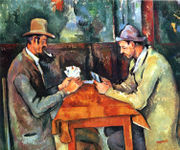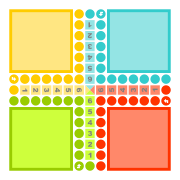Game
2008/9 Schools Wikipedia Selection. Related subjects: Games

A game is a structured or semi-structured activity, usually undertaken for enjoyment and sometimes also used as an educational tool. Games are generally distinct from work, which is usually carried out for remuneration, and from art, which is more concerned with the expression of ideas. However, the distinction is not clear-cut, and many games are also considered to be work or art.
Key components of games are goals, rules, challenge, and interactivity. Games generally involve mental or physical stimulation, and often both. Many games help develop practical skills, serve as a form of exercise, or otherwise perform an educational, simulational or psychological role.
Known to have been played as far back as the 30th century BC, games are a universal part of human experience and present in all cultures. The Royal Game of Ur, Senet and Mancala are some of the oldest known games.
Definitions
Ludwig Wittgenstein
Ludwig Wittgenstein was probably the first academic philosopher to address the definition of the word game. In his Philosophical Investigations, Wittgenstein demonstrated that the elements of games, such as play, rules, and competition, all fail to adequately define what games are. He subsequently argued that the concept "game" could not be contained by any single definition, but that games must be looked at as a series of definitions that share a " family resemblance" to one another.
Roger Caillois
French sociologist Roger Caillois, in his book Les jeux et les hommes (Games and Men) , defined a game as an activity that must have the following characteristics:
- fun: the activity is chosen for its light-hearted character
- separate: it is circumscribed in time and place
- uncertain: the outcome of the activity is unforeseeable
- non-productive: participation is not productive
- governed by rules: the activity has rules that are different from everyday life
- fictitious: it is accompanied by the awareness of a different reality
Chris Crawford
Computer game designer Chris Crawford attempted to define the term game using a series of dichotomies:
- Creative expression is art if made for its own beauty, and entertainment if made for money. (This is the least rigid of his definitions. Crawford acknowledges that he often chooses a creative path over conventional business wisdom, which is why he rarely produces sequels to his games.)
- A piece of entertainment is a plaything if it is interactive. Movies and books are cited as examples of non-interactive entertainment.
- If no goals are associated with a plaything, it is a toy. (Crawford notes that by his definition, (a) a toy can become a game element if the player makes up rules, and (b) The Sims and SimCity are toys, not games.) If it has goals, a plaything is a challenge.
- If a challenge has no “active agent against whom you compete,” it is a puzzle; if there is one, it is a conflict. (Crawford admits that this is a subjective test. Some games with noticeably algorithmic artificial intelligence can be played as puzzles; these include the patterns used to evade ghosts in Pac-Man.)
- Finally, if the player can only outperform the opponent, but not attack them to interfere with their performance, the conflict is a competition. (Competitions include racing and figure skating.) However, if attacks are allowed, then the conflict qualifies as a game.
Crawford's definition may thus be rendered as: an interactive, goal-oriented activity, active agents to play against, which any player (including active agents) could interfere one another.
Crawford also notes (ibid.) several other definitions:
- “A form of play with goals and structure.” ( Kevin Maroney)
- “A game is a form of art in which participants, termed players, make decisions in order to manage resources through game tokens in the pursuit of a goal.” ( Greg Costikyan)
- “An activity with some rules engaged in for an outcome.” ( Eric Zimmerman)
Gameplay elements and classification
Games can be characterized by "what the player does." This is often referred to as gameplay, a term that arose among computer game designers in the 1980s but as of 2007 is starting to see use in reference to games of other forms. Major key elements identified in this context are tools and rules which define the overall context of game and which in turn produce skill, strategy, and chance.
Tools
Games are often classified by the components required to play them (e.g. miniatures, a ball, cards, a board and pieces or a computer). In places where the use of leather is well established, the ball has been a popular game piece throughout recorded history, resulting in a worldwide popularity of ball games such as rugby, basketball, football, cricket, tennis and volleyball. Other tools are more idiosyncratic to a certain region. Many countries in Europe, for instance, have unique standard decks of playing cards. Other games such as chess may be traced primarily through the development and evolution of its game pieces.
Many game tools are tokens, meant to represent other things. A token may be a pawn on a board, play money, or an intangible item such as a point scored.
Games such as hide-and-seek or tag do not utilise any obvious tool. Rather its interactivity is defined by the environment. Games with the same or similar rules may have different gameplay if the environment is altered. For example, hide-and-seek in a school building differs from the same game in a park; an auto race can be radically different depending on the track or street course, even with the same cars.
Rules
Where as games are often characterized by their tools, they are often defined by their rules. While rules are subject to variations and changes, enough change in the rules usually results in a "new" game. For instance, baseball can be played with "real" baseballs or with wiffleballs. However, if the players decide to play with only three bases, they are arguably playing a different game.
Rules generally determine turn order, the rights and responsibilities of the players, and each player’s goals. Player rights may include when they may spend resources or move tokens. Common win conditions are being first to amass a certain quota of points or tokens (as in Settlers of Catan), having the greatest number of tokens at the end of the game (as in Monopoly), or some relationship of one’s game tokens to those of one’s opponent (as in chess's checkmate).
Skill, strategy, and chance
A game’s tools and rules will result in its requiring skill, strategy, chance or a combination thereof, and are classified accordingly.
Games of skill include games of physical skill, such as wrestling, tug of war, hopscotch, target shooting, and stake and games of mental skill such as checkers and chess. Games of strategy include checkers, chess, go, arimaa, and tic-tac-toe, and often require special equipment to play them. Games of chance include gambling games (blackjack, mah jong, roulette etc.), as well as snakes and ladders and rock, paper, scissors; most require equipment such as cards or dice. However, most games contain two or all three of these elements. For example, American football and baseball involve both physical skill and strategy while tiddlywinks, poker and Monopoly combine strategy and chance.
Single-player games
Most games require multiple players. However, Single-player games are unique in respect to the type of challenges a player faces. Unlike a game with multiple players competing with or against each other to reach the game's goal, a one-player game is a battle solely against an element of the environment (an artificial opponent), against one's own skills, against time or against chance. Playing with a yo-yo or playing tennis against a wall is not generally recognised as playing a game due to the lack of any formidable opposition. This is not true, though, for a single-player computer game where the computer provides opposition.
Sport

Many sports require special equipment and dedicated playing fields, leading to the involvement of a community much larger than the group of players. A city or town may set aside such resources for the organisation of sports leagues.
Popular sports may have spectators who are entertained just by watching games. A community will often align itself with a local sports team that supposedly represents it (even if the team or most of its players only recently moved in); they often align themselves against their opponents or have traditional rivalries. The concept of fandom began with sports fans.
Stanley Fish cited the balls and strikes of baseball as a clear example of social construction, the operation of rules on the game's tools. While the strike zone target is governed by the rules of the game, it epitomizes the category of things that exist only because people have agreed to treat them as real. No pitch is a ball or a strike until it has been labeled as such by an appropriate authority, the plate umpire, whose judgment on this matter cannot be challenged within the current game.
Certain competitive sports, such as racing and gymnastics, are not games by definitions such as Crawford's (see above, despite the inclusion of many in the Olympic Games) because competitors do not interact with their opponents, they simply challenge each other in indirective ways.
Lawn games
Lawn games are outdoor games that can be played on a lawn. Many games that are traditionally played on a pitch are marketed as "lawn games" for home use in a front or back yard. Common lawn games include Horseshoes, Sholf, Croquet, Bocce and Stake.
Board games

Board games use as a central tool a board on which the players' status, resources, and progress are tracked using physical tokens. Many also involve dice and/or cards. Most games that simulate war are board games, and the board may be a map on which the players' tokens move. Some games, such as chess and go, are entirely deterministic, relying only on the strategy element for their interest. Children's games, on the other hand, tend to be very luck-based, with games such as Candy Land having virtually no decisions to be made. Trivia games have a great deal of randomness based on the questions a person gets. German-style board games are notable for often having rather less of a luck factor than many board games.
Card games
Card games use as a central tool a deck of cards. The cards may be a standard Anglo-American (52-card) deck of playing cards (such as Go Fish or Crazy Eights), a regional deck using 32, 36 or 40 cards and different suit signs, a tarot deck, or a deck specific to the individual game (such as Set). Uno and Rook are examples of games that were originally played with a standard deck and have since been commercialized with customized decks. Some collectible card games such as Magic: The Gathering are played with a small selection of cards which have been collected or purchased individually from large available sets.
Video games
Video games are computer- or microprocessor-controlled games. Computers can create virtual tools to be used in a game, such as cards or dice, or far more elaborate worlds where mundane or fantastic things can be manipulated through gameplay.
A computer or video game uses one or more input devices, typically a button/ joystick combination (on arcade games); a keyboard, mouse and/or trackball (computer games); or a controller or a motion sensitive tool. ( console games). More esoteric devices such as paddle controllers have also been used for input. In computer games, the evolution of user interfaces from simple keyboard to mouse, joystick or joypad has profoundly changed the nature of game development.
In more open-ended computer simulations, aka sandbox-style games, the player may be free to do whatever they like within the confines of the virtual universe. Sometimes, there is a lack of goals or opposition, which has stirred some debate on whether these should be considered "games" or "toys". (Crawford specifically mentions Will Wright’s SimCity as an example of a toy.)
Online games
From the very earliest days of networked and timeshared computers, online games have been part of the culture. Early commercial systems such as Plato were at least as widely famous for their games as for their strictly educational value. In 1958, Tennis for Two dominated Visitor's Day and drew attention to the oscilloscope at the Brookhaven National Laboratory; during the 1980s, Xerox PARC was known mainly for Maze War, which was offered as a hands-on demo to visitors.
Modern online games are played using an Internet connection; some have dedicated client programs, while others require only a Web browser. Some simpler browser games appeal to demographic groups (notably women and the middle-aged) that otherwise play very few video games. Some games can be played in browser. The computer game is the most established of all sectors of the emergent new media landscape. The media is transformed from the traditional way of circulating in just one way to an interactive way. This is the phenomenon that is broadening around the world of videogame. It is an obvious example of the ways in which online and offline space can be seen as ‘merged’ rather than separate.
Media audiences’ characteristic has been changing in consequence of the social changes and development. They are becoming active and interact more than ever before. The players of the game in this phenomenon are just like the social formation in our society. They are both self-regulating, creating their own social norms and subject to regulation and constraint through the code of the game and sometimes through the policing of the game by those who run it. The values that are policed vary from game to game. Many of the values encoded into game cultures reflect offline cultural values, but games also offer a chance to emphasis alternative or subjugated values in the name of fantasy and play. The players of the game at the new century are now apparently expressing their profound self through the game. When they can play with their anonymous status, they are found to be more confident to express and to step out from the position they have never been out from. It offers new experiences and pleasures based in the interactive and immersive possibilities of computer technologies.
Role-playing games
Role-playing games, often abbreviated as RPGs, are a type of game in which the participants (usually) assume the roles of characters acting in a fictional setting. The original role playing games—or at least those explicitly marketed as such—are played with a handful of participants, usually face-to-face, and keep track of the developing fiction with pen and paper. Together, the players may collaborate on a story involving those characters; create, develop, and "explore" the setting; or vicariously experience an adventure outside the bounds of everyday life. Pen-and-paper role-playing games include, for example, Dungeons & Dragons and GURPS. Modern independent RPGs, however, often blur the line between the more traditional idea of the RPG and other traditional genres, or border on story-telling.
The term role-playing game has also been appropriated by the video game industry to describe a genre of video games. These may be single-player games where one player experiences a programmed environment and story, or they may allow players to interact through the internet. The experience is usually quite different than traditional role-playing games. Single-player games include Final Fantasy, Fable: The Lost Chapters, and The Elder Scrolls. Online multi-player games, often referred to as Massively Multiplayer Online role playing games, or MMORPGs, include RuneScape, EverQuest 2, Guild Wars, MapleStory and Anarchy Online. As of 2008, the most successful MMO has been World of Warcraft, which controls the vast majority of the market.
